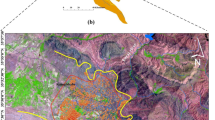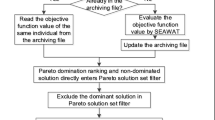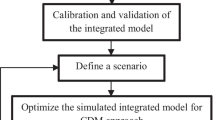Abstract
Groundwater is one of the most valuable water resources in the world in terms of quantity and quality. Therefore, their protection as an important issue should be considered by the operating managers. Among the types of existing groundwater aquifers, the coastal aquifers need more protection because they could be contaminated by salt in the result of seawater intrusion. Their protection is a priority based on an optimal and comprehensive management model. Increasement of demands in these areas, especially in recent years, requires sustainable and optimal management as one of the main objectives for long-term operation in the future. In order to meet this purpose, a simulation-optimization model of Bandargaz-Nokandeh coastal groundwater system that located in the north of Iran was proposed by the employment of the Groundwater Modeling System (GMS) numerical model and the Non-Dominate Sorting Genetic Algorithm-II (NSGA-II) multi-objective evolutionary optimization algorithm. In this study based on the quantitative simulated groundwater model; two managerial issues have been examined; including the control of water-table drawdown and sustainability of extraction from the wells in this aquifer. By combining these two models and implementing them, optimal withdrawal scenarios which examines different aspects of the study objectives, have been extracted. Regarding the decision-making methods of Simple Additive Weighting (SAW), Gray Relational Analysis (GRA), and Berda Aggregation method (BAM), the best scenario was determined among the points located on the optimal trade-off curve. The results show that implementations of management strategies to create a sustainable development of the Bandargaz-Nokandeh coastal aquifer, has led to a 48.45 percent decrease in water withdrawal. Also, the comparison of the groundwater table level (GWTL) under the two existing and optimal operating conditions shows a 29.54% reduction (monthly average) in the area of aquifer that contain drawdown in the GWTL. This reduction varies from 1.43% in October 2011 to 59.22% in September 2012. Based on this optimal operation policy, the consequences of excessive withdrawal, and more than the natural capacity of the aquifer, could be compensated. Besides that, in order to the sustainable development of the aquifer can be controlled the amount of water extracted from operation wells.






















Similar content being viewed by others
Data Availability
Data and material would be made available on request.
References
Abdullah AM, Raveena SM, Aris AZ (2010) A numerical modelling of seawater intrusion into an oceanic island aquifer, Sipadan Island, Malaysia. Sains Malays 39(4):525–532
Akbarpour S, Niksokhan MH (2018) Investigating effects of climate change, urbanization, and sea level changes on groundwater resources in a coastal aquifer: an integrated assessment. Environ Monit Assess 190(10):1–16
Al-Maktoumi A, Rajabi MM, Zekri S, Triki C (2021) A probabilistic multiperiod simulation-optimization approach for dynamic coastal aquifer management. Water Resour Manag 35:3447–3462
Anderson MP, Woessner WW, Hunt RJ (1992) Applied groundwater modeling: simulation of flow and advective transport. Academic Press Inc., San Diego, CA
Aswed El Ahmed N, Ali TAM, Bin Ghazali AH, Yosef ZBM (2018) Simulation of different pumping scenarios on the groundwater-sea water intrusion in to the tripoli aquifer, Libya. J Eng Sci Technol 13(10):3419–3431
Ataie-Ashtiani B, Ketabchi H (2011) Elitist continuous ant colony optimization algorithm for optimal management of coastal aquifers. Water Resour Manag 25(1):165–190
Banihabib MA, Tabari MMR, Tabari MMR (2017) Development of a multi-purpose integration approach for optimal redistribution of water resources in agricultural systems. Case Study: Zarrinehroud Basin, Iranian. Water Resour Res 13(1):52–38 (In Persian)
Bizhani-Manzar M, Mahjouri N (2013) Waste load allocation in Zarjub River: application of borda scoring social choice and Nash bargaining methods. Iran Water Resour Res 9(3):59–74 (In Persian)
Chang SW, Clement TP, Simpson MJ, Lee KK (2011) Does sea-level rise have an impact on saltwater intrusion? Adv Water Resour 34(10):1283–1291
Chen L, McPhee J, Yeh WWG (2007) A diversified multiobjective GA for optimizing reservoir rule curves. Adv Water Resour 30(5):1082–1093
Deb K, Agrawal S, Pratap A, Meyarivan T (2000) A fast elitist non-dominated sorting genetic algorithm for multi-objective optimization: NSGA-II. Kanpur Genetic Algorithm Laboratory (KanGAL) Report 200001, Indian Institute of Technology, Kanpur, India
Dunlop G, Palanichamy J, Kokkat A, James EJ, Palani S (2019) Simulation of saltwater intrusion into coastal aquifer of Nagapattinam in the lower cauvery basin using SEAWAT. Groundw Sustain Dev 8:294–301. https://doi.org/10.1016/j.gsd.2018.11.014
Fan Y, Lu W, Miao T, Li J, Lin J (2020) Multiobjective optimization of the groundwater exploitation layout in coastal areas based on multiple surrogate models. Environ Sci Pollut Res 27:19561–19576
Hajiabadi R, Zarghami M (2014) Multi-objective reservoir operation with sediment flushing: case study of Sefidrud reservoir. Water Resour Manag 28(15):5357–5376
Hallaji K, Yazicigil H (1996) Optimal management of a coastal aquifer in southern Turkey. J Water Resour Plan Manag 122(4):233–244
Huang PS, Chiu YC (2018) A simulation-optimization model for seawater intrusion management at pingtung coastal area, Taiwan. Water 10(3):251. https://doi.org/10.3390/w10030251
Karatzas GP, Dokou Z (2015) Optimal management of saltwater intrusion in the coastal aquifer of Malia, Crete (Greece), using particle swarm optimization. Hydrogeol J 23(6):1181–1194
Karterakis SM, Karatzas GP, Nikolos IK, Papadopoulou MP (2007) Application of linear programming and differential evolutionary optimization methodologies for the solution of coastal subsurface water management problems subject to environmental criteria. J Hydrol 342(3–4):270–282
Ketabchi H, Ataie-Ashtiani B (2015) Coastal groundwater optimization-advances, challenges, and practical solutions. Hydrogeol J 23(6):1129–1154
Kourakos G, Mantoglou A (2015) An efficient simulation-optimization coupling for management of coastal aquifers. Hydrogeol J 23(6):1167–1179
Lal A, Datta B (2019) Optimal pumping strategies for the management of coastal groundwater resources: application of Gaussian Process Regression metamodel-based simulation-optimization methodology. ISH J Hydraul Eng 1–10. https://doi.org/10.1080/09715010.2019.1599304
Luyun R Jr, Momii K, Nakagawa K (2009) Laboratory-scale saltwater behavior due to subsurface cutoff wall. J Hydrol 377(3–4):227–236
Mostafaei-Avandari M, Ketabchi H (2020) Coastal groundwater management by an uncertainty-based parallel decision model. J Water Resour Plan Manag 146(6):04020036
Nemati M, Tabari MMR, Hosseini SA, Javadi S (2021) A novel approach using hybrid fuzzy vertex method-MATLAB framework based on GMS model for quantifying predictive uncertainty associated with groundwater flow and transport models. Water Resour Manag 35:4189–4215
Ranjbar A, Cherubini C, Saber A (2020) Investigation of transient sea level rise impacts on water quality of unconfined shallow coastal aquifers. Int J Environ Sci Technol 17:2607–2622
Rejani R, Jha MK, Panda SN, Mull R (2008) Simulation modeling for efficient groundwater management in Balasore coastal basin, India. Water Resources Management 22:23–50
Song J, Yang Y, Wu J, Wu J, Sun X, Lin J (2018) Adaptive surrogate model based multiobjective optimization for coastal aquifer management. J Hydrol 561:98–111
Sowe MA, Sathish S, Greggio N, Mohamed MM (2020) Optimized pumping strategy for reducing the spatial extent of saltwater intrusion along the coast of Wadi Ham, UAE. Water 12(5):1503. https://doi.org/10.3390/w12051503
Tabari MMR, Soltani J (2013) Multi-objective optimal model for conjunctive use management using SGAs and NSGA-II models. Water Resour Manag 27(1):37–53
Todd DK (2005) Groundwater hydrology. John Wiley, New York, 636 p
Trichakis I, Burek P, de Roo A, Pistocchi A (2017) Towards a pan-European integrated groundwater and surface water model: development and applications. Environ Process 4:81–93
Vaux H (2011) Groundwater under stress: the importance of management. Environ Earth Sci 62(1):19–23
Wang Z, Rangaiah GP (2017) Application and analysis of methods for selecting an optimal solution from the pareto-optimal front obtained by multiobjective optimization. Ind Eng Chem Res 56:560–574. https://doi.org/10.1021/acs.iecr.6b03453
Werner AD, Bakker M, Post VE, Vandenbohede A, Lu C, Ataie-Ashtiani B, Barry DA (2013) Seawater intrusion processes, investigation and management: recent advances and future challenges. Adv Water Resour 51:3–26
Xu Z, Hu BX, Xu Z, Wu X (2019) Simulating seawater intrusion in a complex coastal karst aquifer using an improved variable-density flow and solute transport–conduit flow process model. Hydrogeol J 27:1277–1289
Yihdego Y, Al-Weshah RA (2017) Assessment and prediction of saline sea water transport in groundwater using 3-D numerical modelling. Environ Process 4:49–73
Zeinali M, Azari A, Heidari MM (2020) Multiobjective optimization for water resource management in low-flow areas based on a coupled surface water-groundwater model. J Water Resour Plan Manag 146(5):04020020
Zeinali M, Azari A, Heidari MM (2020) Simulating unsaturated zone of soil for estimating the recharge rate and flow exchange between a river and an aquifer. Water Resour Manag 34:425–443
Author information
Authors and Affiliations
Contributions
Mahmoud Mohammad Rezapour Tabari: Conceptualization, Supervision, Methodology, Visualization, Editing of manuscript; Mahbobeh Abyar: Conceptualization, Data acquisition, Writing- Original draft preparation,
Corresponding author
Ethics declarations
Consent to Participate
Not Applicable.
Consent to Publish
Not Applicable.
Competing Interests
The authors declare that they have no known competing financial interests or personal relationships that could have appeared to influence the work reported in this paper.
Additional information
Publisher's Note
Springer Nature remains neutral with regard to jurisdictional claims in published maps and institutional affiliations.
Rights and permissions
About this article
Cite this article
Tabari, M.M.R., Abyar, M. Development a Novel Integrated Distributed Multi-objective Simulation-optimization Model for Coastal Aquifers Management Using NSGA-II and GMS Models. Water Resour Manage 36, 75–102 (2022). https://doi.org/10.1007/s11269-021-03012-0
Received:
Accepted:
Published:
Issue Date:
DOI: https://doi.org/10.1007/s11269-021-03012-0




